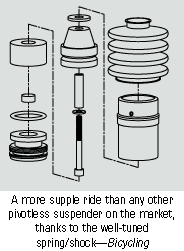
 |
|||||
Fango Chainstay Technology
Although simple in construction, the Fango is a highly evolved mechanical structure. Designed using advanced engineering techniques, extensive computer modeling and a fair amount of ingenuity, the Fango is the only pivotless aluminum suspension bike available. Why is “pivotless aluminum suspension” significant? Pivotless frames need no maintenance. Aluminum is lightweight and offers the most bang for the buck. Suspension allows you to ride longer and harder over rougher terrain with more control and endurance.

The Fango features our unique Flat-Plate Chainstay technology, which combines lateral rigidity for precise handling with vertical flexibility for a plush ride. At first thought, one might not embrace the idea of flexible aluminum. As we know, fat aluminum tubes--like downtubes, aircraft fuselages, and beer cans—are not designed to flex, and are indeed very stiff. Enter John Castellano, who points out that 747 wings, which flex up and down 30-something feet, are made from aluminum. They can flex because they are thin. The wings are the suspension system for the plane. We begin to see that properly designed thin members like skateboards, skis, airplane wings, and even chainstays can be designed to flex safely.
One challenge is making the chainstay strong and stiff laterally, yet capable of vertical travel. To withstand chain loads, and side loads imposed by the tire, the Fango chainstay’s shape is wide laterally, especially on the left side where more room is available. It has triangular openings, kind of like a bridge lying on its side, which gives it tremendous lateral stiffness. However the Fango’s chainstay is thin, when viewed from the side, allowing it to flex vertically. The outer shape and the shape of the openings are carefully optimized to keep stresses uniformly low. For extra durability, we custom extrude the chainstay from special high-strength 6069 aluminum.
John’s earlier escapades at pivotless bicycle frame construction include the Ibis BowTi and the Ibis SilkTi. These experiences allowed John to conceptualize and then build the aluminum Fango, his most ambitious and mind-bending engineering exercise to date. Extensive use of the sophisticated engineering software packages called ProEngineer and Mechanica allowed John to optimize the design for the anticipated loads, while keeping weight to a minimum. Prototypes were then destructively tested in the laboratory to verify that design goals were reached or exceeded. Test results indicate that if you rode for three hours every day, and bottomed the suspension every ten seconds, the chainstay would last over sixty years!
If you really like all this techno mumbo jumbo and want to dig even deeper, you can read the patent here.
This series of stress plots tracks the Fango chainstay
shape optimization for lateral loads from the first prototypes to the finished product.
The Fango’s front triangle also received the benefits of John’s computer optimization. The main triangle tubes have been optimally butted and dimensioned for the unique requirements of a softail. Those requirements lend themselves well to the custom butting that is available only in aluminum. The unique combination of fat butted frame tubes with the Flat-Plate Chainstays provides 1.25” of travel with a weight of only 4.4 pounds, including the shock.
The CDE Shock
One design challenge on a short-travel bike is to both absorb small bumps and control big impacts effectively. John Castellano has designed, patented and manufactured the Critically Damped Elastomer (CDE) Shock, which improves performance throughout the range of travel, compared to other types of shocks. Critical damping means “not too much, not too little”—just right.
The CDE shock is a compact, lightweight, reliable unit. It’s actually a two-stage shock providing isolation from small and large bumps alike. The first stage provides high-frequency isolation; for those smaller, but ultimately fatiguing bumps you encounter along the entire route of your ride. Interestingly, oil-damped airshocks are not as good at providing this high-frequency isolation on a short-travel bike, because the stiff spring and high damping rates required with this type of shock actually transmit, rather than absorb, high frequency harshness.
The CDE’s second stage is progressive, meaning the spring rate and damping increases as you increase the shock travel. The bigger the bump, the more the shock works to control the bump forces. This position-sensitive damping works on both compression and rebound to keep the tire pinned to the ground under all conditions.

Though sophisticated in function, the CDE is an exceedingly simple shock, with only 11 parts, and no pivots. All parts are user serviceable, and easy to replace. Grease ports are provided, to make it easy to maintain the shock. Each shock is custom tuned for rider size and weight. The shock is adjustable over a range of ±30 lb. in rider weight. In addition, you may order stiffer or softer springs for the shock to suit your own needs.